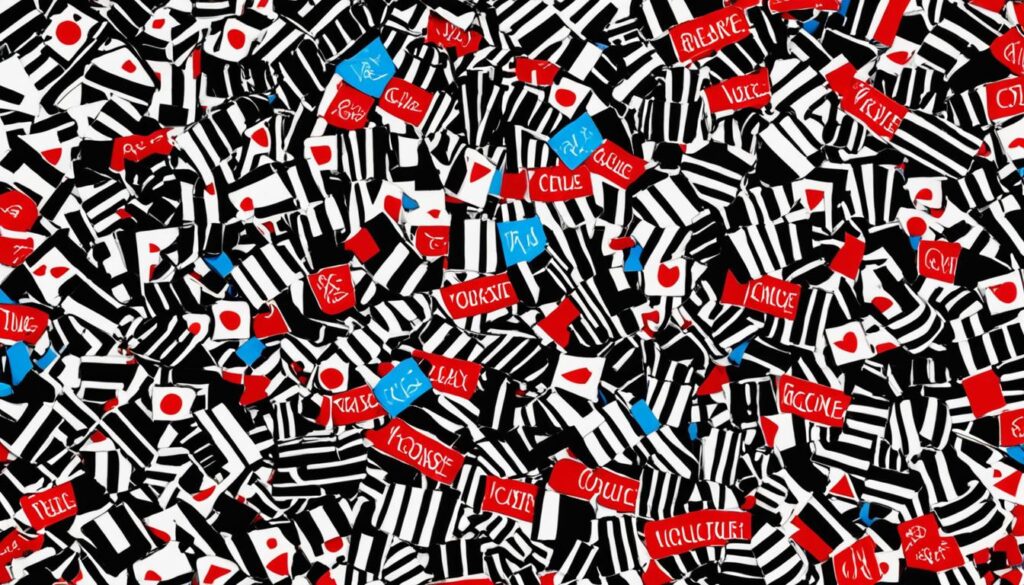Consumer culture has a profound impact on individuals and society as a whole. The influence of consumer culture, characterized by the pursuit of material wealth and the constant desire for more, has been extensively studied by psychologists and researchers. Surprisingly, the findings show that the relationship between consumer culture and happiness is not a positive one.
A literature review conducted by psychologist David G. Myers revealed that despite living in a more affluent society, today’s young adults are not any happier than their grandparents were in 1957. The increase in material wealth and the consumer culture of today has not led to increased subjective well-being. In fact, there is evidence that individuals who place high value on material possessions and wealth tend to be unhappier, even if they have less financial stress.
Why does consumer culture fail to bring happiness? One reason is that the pursuit of material wealth often comes at the expense of other aspects of life that contribute to well-being, such as fulfilling relationships and meaningful pursuits. The constant obsession with acquiring more possessions can leave individuals feeling empty and unsatisfied. Moreover, the pressure to keep up with the latest trends and “keeping up appearances” can lead to financial and emotional insecurity.
Key Takeaways:
- Consumer culture, with its focus on material wealth, does not lead to increased subjective well-being.
- Individuals who prioritize material possessions are often unhappier.
- The pursuit of material wealth can take time away from relationships and soul-satisfying pursuits, leading to unhappiness.
- Insecurity, both financial and emotional, is a contributing factor to materialistic values.
The Influence of Unfavorable Brand Image on Consumer Brand Hate
A study conducted on mobile phone users reveals the significant impact of unfavorable brand image on consumer brand hate. When consumers develop a negative perception of a brand, they are more likely to engage in anti-brand actions, such as negative word of mouth and ultimately exiting the brand. The findings emphasize the critical need for marketers to assess and manage brand image effectively in order to mitigate the negative reactions from consumers.
Although this study specifically focused on mobile phone users, further research is necessary to investigate the influence of unfavorable brand image across different industries. Understanding the underlying factors that contribute to consumer brand hate can enable companies to implement targeted strategies to improve their brand’s perception and mitigate potential negative outcomes.
Impact on Consumer Behavior
The negative perception of a brand can significantly impact consumer behavior, leading to a variety of detrimental outcomes. Here are some key consequences of unfavorable brand image:
- Negative Word of Mouth: Consumers who hold an unfavorable view of a brand are more likely to share their dissatisfaction with others, spreading negative word of mouth. This can further damage the brand’s reputation and influence the purchasing decisions of potential customers.
- Exit Behavior: When consumers perceive a brand negatively, they are more inclined to sever their connection with the brand. This can manifest as customers switching to competitors or completely abandoning the brand, resulting in lost revenue and market share.
Given the influence of unfavorable brand image on consumer behavior, it becomes imperative for companies to proactively manage their brand perception and address any negative associations that may arise.
“A negative brand image can create a ripple effect, leading to consumer brand hate and detrimental anti-brand actions. Marketers must prioritize brand image assessment and management to mitigate negative consumer reactions and safeguard the brand’s reputation.”
The Rise of Brand Activism and its Dark Side
As consumer expectations evolve, brands are embracing brand activism as a way to connect with their audience and promote social change. By aligning themselves with social causes, brands are leveraging their influence to address important issues and engage consumers on a deeper level. However, while brand activism is often viewed as a positive force, it can also have negative consequences.
Brand activism refers to the practice of brands taking a stand on social, political, and environmental issues. Instead of solely focusing on their products or services, brands are incorporating a social purpose into their messaging and actions. This shift reflects a growing desire among consumers for brands to embody values that extend beyond profit.
However, it is important to acknowledge the potential negative impact of brand activism. When brands take a stance on controversial issues, they risk fueling existing controversies and creating new ones. This can lead to division among consumers and even radicalization. While brand activism aims to promote dialogue and social reform, it can inadvertently foster hate and animosity. Therefore, a comprehensive understanding of how and when brand activism promotes hate or dialogue is essential.
“Brand activism presents a unique opportunity for brands to connect with their audience on a deeper level and make a positive impact. However, it is crucial for brands to approach activism with a thoughtful and inclusive mindset to mitigate the negative consequences that may arise.”
To gain a better understanding of the impact of brand activism, it is important to study real-life examples and analyze their effects. One such example is the controversial advertising campaign by global sportswear brand Nike featuring Colin Kaepernick, the former NFL player known for his protests against racial injustice. While the campaign received praise for its bold activism, it also faced backlash and calls for boycotts from some consumers.
| Positive Impact | Negative Impact |
|---|---|
| Increased brand loyalty among socially conscious consumers | Boycotts and loss of customers who disagreed with the brand’s stance |
| Enhanced brand reputation as a socially responsible company | Damage to brand image among consumers who perceive the activism as divisive |
| Opportunities for constructive dialogue and awareness | Increased polarization among consumers with differing views |

These examples highlight the multidimensional impact of brand activism, showcasing both its potential positive and negative outcomes. Marketers and researchers must delve deeper into this topic to develop strategies that navigate the complexities of brand activism and its impact on society. By understanding the dark side of brand activism and how it can promote hate, brands can strive for more responsible and inclusive activism.
The Relationship Between Regressive and Woke Brands and Distrust, Division, and Hate
Both regressive and woke brands have a significant influence on shaping dynamics of distrust, division, and hate within society. Regressive brands often promote values that reject societal progress, reinforcing traditional norms and beliefs. On the other hand, woke brands, driven by the desire for social change, can unintentionally trigger polarizing debates and contribute to the division among consumers.
Regressive brands, by perpetuating regressive ideologies and promoting outdated values, can fuel existing social divides. These brands may appeal to a certain demographic that longs for a return to the past, leading to increased distrust and animosity towards those who hold different views.
Conversely, woke brands, with their focus on justice and equality, often champion controversial causes and take a stance on divisive issues. While this may resonate with some consumers, it can fuel further division and hate when these brands inadvertently create an “us vs. them” mentality, discouraging constructive dialogue and understanding.
Both types of brands play a critical role in shaping consumer beliefs, values, and political positions. Their messaging and actions contribute to the increasing polarization and radicalization seen in society today. Consumers align themselves with either regressive or woke brands, reinforcing their own ideologies and further deepening the divisions between different groups.
It is imperative to examine the impact of different types of brands on social dynamics and the potential negative consequences their actions may have. By understanding the relationship between regressive and woke brands and the dynamics of distrust, division, and hate, we can develop strategies to foster empathy, bridge gaps, and promote a more inclusive and harmonious society.

Through a balanced and nuanced approach, businesses can navigate the delicate line between promoting their brand values and exacerbating societal division. Brand activism should aim to inspire productive conversations and bridge gaps, rather than perpetuate hate and division.
The Impact of Small/Niche, National, and Global Activist Brands on Polarization and Radicalization
Activist brands play a significant role in shaping societal dynamics, with their actions having the potential to promote polarization and radicalization among consumer-citizens. These brands come in different forms, from small/niche brands that target specific communities or causes, to national and global brands that have a broader reach and influence.
By tapping into consumer identities and values, activist brands have the power to influence attitudes and behaviors. They align themselves with specific social movements or causes, creating a sense of affiliation and mobilizing consumer support. However, the consequences of their actions extend beyond individual empowerment and social change.
It is crucial to study the impact of different types of activist brands on polarization and radicalization to understand the broader consequences they can have on society. This research requires a cross-disciplinary approach and access to specific data for a comprehensive analysis.

Activist brands can contribute to polarization by amplifying conflicting viewpoints and creating an “us versus them” mentality. For instance, the actions of global activist brands that take a stance on controversial issues can ignite heated debates and further divide society. Similarly, the rise of small/niche activist brands can reinforce echo chambers, restricting exposure to differing perspectives and reinforcing existing beliefs.
Moreover, activist brands have the potential to fuel radicalization among consumers. By associating with radical ideologies or engaging in extreme actions, these brands can attract and influence individuals who are already inclined towards radical beliefs. This can lead to the spread of extremist ideologies and actions, posing a threat to societal harmony.
“The actions of activist brands can either bridge gaps and foster understanding or deepen divisions and promote radicalization.”
To address these issues, it is essential for activist brands to carefully consider the potential consequences of their actions and engage in responsible activism. They should strive to promote dialogue, tolerance, and empathy, rather than further polarizing society. Furthermore, researchers, policymakers, and marketers need to collaborate to better understand the complexities of activism and develop strategies to mitigate the negative effects of polarization and radicalization.
What are the Negative Impacts of Consumer Culture According to Experts?
Experts agree that the impact of consumer culture can be detrimental in various ways. It leads to environmental degradation, excessive materialism, and a focus on instant gratification. Furthermore, it perpetuates a throwaway mentality, leading to waste and a strain on global resources. These negative consequences have long-term effects on both society and the planet.
Conclusion
The influence of consumer culture and brand activism on society cannot be overstated. Both have significant effects on individual well-being and societal dynamics. While the pursuit of material wealth does not necessarily lead to happiness, consumer culture impacts individuals by shaping their desires, priorities, and relationships.
Additionally, brand activism has emerged as a powerful tool for organizations to connect with consumers. It enables brands to take a stand on social and political issues, aligning themselves with consumers’ values and aspirations. However, brand activism is a double-edged sword. While it can promote positive change and encourage dialogue, it can also have negative consequences.
The negative consequences of brand activism include the potential for polarization and radicalization. When brands take a strong stance on controversial issues, it can deepen existing divisions within society and trigger heated debates. This polarization can lead to an erosion of trust and an increase in hate and animosity among consumers.
To mitigate these negative consequences, it is essential for marketers and researchers to gain a deeper understanding of how consumer culture and brand activism shape society. By examining the impact of different types of brands and their actions, strategies can be developed to promote a more positive and harmonious society. Achieving this requires a careful balance between brand purpose and the potential consequences of brand activism, with the aim of fostering unity and constructive dialogue among consumers.
FAQ
What is the impact of consumer culture on society?
Consumer culture can have both positive and negative effects on society. While material wealth and the pursuit of material goods do not necessarily lead to increased happiness, consumerism can lead to unhappiness and dissatisfaction when individuals prioritize material possessions over relationships and personal fulfillment.
How does unfavorable brand image influence consumer brand hate?
When consumers have a negative perception of a brand, they are more likely to engage in anti-brand actions such as negative word of mouth and exit. This highlights the importance for marketers to manage and assess brand image to avoid negative consumer reactions.
What are the positive and negative consequences of brand activism?
Brand activism can be seen as positive as it promotes social reform and aligns with the expectations of consumers who seek brands with a social purpose. However, brand activism can also fuel controversies, create divisions, and promote hate among consumers, highlighting the need for a better understanding of when and how activist brands can promote dialogue or hate.
How do regressive and woke brands contribute to distrust, division, and hate?
Regressive brands may promote values that reject societal progress, while woke brands can trigger polarizing discussions instead of fostering constructive dialogue. Both types of brands have the power to shape consumer beliefs, values, and political positions, potentially leading to increased polarization and radicalization.
What is the impact of small/niche, national, and global activist brands on polarization and radicalization?
Activist brands, regardless of their size or reach, tap into consumer identities and values, influencing their attitudes and behaviors. It is important to study how different types of activist brands contribute to societal polarization and radicalization to understand the broader consequences of their actions.
How can consumer culture and brand activism be better understood and managed?
Consumer culture and brand activism have significant effects on society. Understanding how consumer culture influences well-being and how brand activism influences societal dynamics is crucial. This knowledge can help marketers and researchers develop strategies to mitigate negative consequences such as polarization and radicalization, promoting a more positive and harmonious society.

